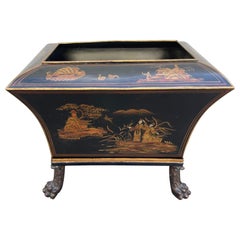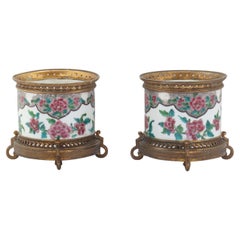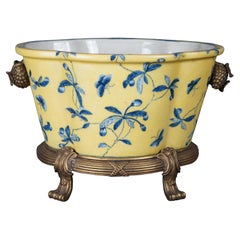Cache Pot Chinoiserie
20th Century Chinoiserie Planters, Cachepots and Jardinières
Brass, Tôle
20th Century Chinese Chinoiserie Planters, Cachepots and Jardinières
Porcelain
Recent Sales
Antique 1870s French Chinoiserie Planters, Cachepots and Jardinières
Ormolu
20th Century Chinoiserie Planters, Cachepots and Jardinières
Bronze
Antique Late 19th Century Chinese Chinoiserie Planters, Cachepots and Ja...
Enamel, Bronze, Copper
Late 20th Century Chinoiserie Planters, Cachepots and Jardinières
Porcelain
Late 20th Century Chinoiserie Planters and Jardinieres
Walnut
Mid-20th Century Chinoiserie Figurative Sculptures
Jade
Late 20th Century Chinoiserie Urns
Ceramic
Antique 19th Century French Vases
Mid-20th Century Chinoiserie Planters, Cachepots and Jardinières
Tôle
Antique Late 19th Century Chinoiserie Planters, Cachepots and Jardinières
Tôle
Antique 19th Century Chinoiserie Planters, Cachepots and Jardinières
Ceramic
People Also Browsed
2010s American Table Lamps
Brass
Antique 19th Century American Country Farm Tables
Pine
21st Century and Contemporary Asian Rustic Cabinets
Wood
Vintage 1950s American Mid-Century Modern Side Tables
Maple
Early 20th Century French Louis XV Sideboards
Belgian Black Marble
Late 20th Century French Louis XVI Sideboards
Mahogany
Antique Mid-19th Century French Empire Center Tables
Marble, Brass
20th Century Chinoiserie Side Tables
Brass
Vintage 1930s French Louis XVI Console Tables
Marble
Mid-20th Century American Mid-Century Modern Patio and Garden Furniture
Metal, Wrought Iron
20th Century French Louis XVI Sideboards
Mahogany
Late 20th Century American Chinoiserie Side Tables
Brass
Late 20th Century Louis XV Side Tables
Marble, Bronze
Antique 19th Century Chinese Paintings and Screens
Glass
20th Century Victorian Table Lamps
Metal
21st Century and Contemporary Vietnamese Rustic Console Tables
Wood
A Close Look at Chinoiserie Furniture
Emerging in the 17th century, chinoiserie appropriated the aesthetics and imagery of popular East Asian design for European-made versions. Reflecting the exoticization of China, Japan and other countries in this era, the word directly translates from French to “Chinese-esque,” which reveals its shortcomings as a style of furniture and decor that often stereotypically and reductively mimics Asian culture rather than showcasing and paying tribute to its artistic traditions.
The enthusiastically decorative chinoiserie style was propelled by influential tastemakers including French King Louis XIV, whose Trianon de Porcelaine in 1670 was inspired by Chinese architecture. Expanded trade between the East and West led to a demand for porcelain, lacquer objects, silk and other goods, which further informed the fanciful furniture being crafted in Europe.
Artisans working in the chinoiserie style used materials and elements like pagoda shapes, bamboo, lacquer surfaces, bird and flower motifs and other interpretations of Asian design on pieces that were frequently set against vibrant wallcoverings. This whimsical approach yielded chinoiserie furniture that boasted dramatic flourishes drawing on the natural world and reflected the dominance of Rococo during the 18th century.
As chinoiserie was shaped by approximations of Asian design by European creators, it had regional variations, such as Chinese Chippendale in England where cabinets, chairs and tea tables had wooden fretwork designs and “japanned” surfaces intended to resemble lacquer work that was created in East Asia. In North America, furniture makers in Boston and New York integrated chinoiserie-painted scenes into Queen Anne furniture.
Antique chinoiserie furniture has continued to be fashionable, from its popularity with decorators of the Hollywood Regency era — James Mont, Tommi Parzinger, William Haines and Samuel Marx favored the style — to contemporary interior designers, although it brings with it a complex history.
Find a collection of chinoiserie bedroom furniture, cabinets, decorative objects and more on 1stDibs.
Finding the Right Vases-vessels for You
For thousands of years, vases and vessels have had meaningful functional value in civilizations all over the world. In Ancient Greece, ceramic vessels were used for transporting water and dry goods, holding bouquets of flowers, for storage and more. Outside of utilitarian use, in cities such as Athens, vases were a medium for artistic expression — pottery was a canvas for artists to illustrate their cultures’ unique people, beliefs and more. And pottery skills were handed down from fathers to sons.
Every antique and vintage vase and vessel, from decorative Italian urns to French 19th-century Louis XVI–style lidded vases, carries with it a rich, layered story.
On 1stDibs, there is a vast array of vases and vessels in a variety of colors, sizes and shapes. Our collection features vessels made from delicate materials such as ceramic and glass as well as durable materials like rustproof metals and stone.
A contemporary vase can help introduce an air of elegance to your minimalist space while an antique Chinese jar would make a luxurious addition to an Asian-inspired interior. Alternatively, if you’re looking for a statement piece, consider an Art Deco vase crafted by Italian architect and furniture designer Gio Ponti.
Vases and vessels — be they handmade pots, handblown glass wine bottles or otherwise — are versatile, practical decorative objects, and no matter your particular design preferences, furniture style or color scheme, they can add beauty and warmth to any home. Find yours on 1stDibs today.



